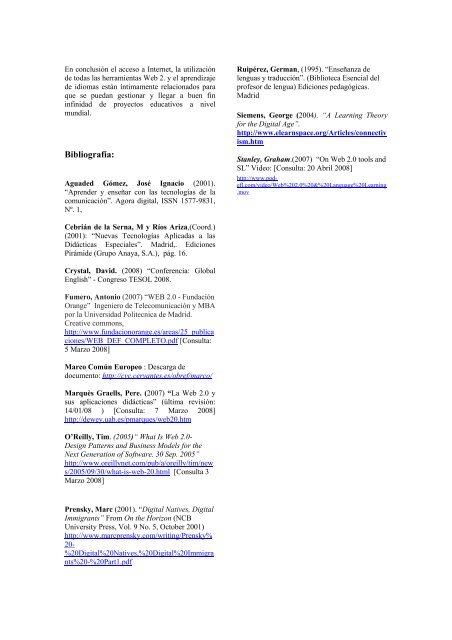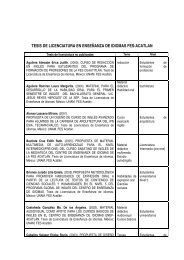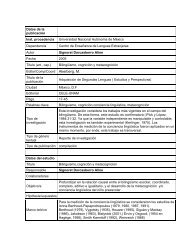Recursos de la Web 2.0 para la Enseñanza de Idiomas.
Recursos de la Web 2.0 para la Enseñanza de Idiomas.
Recursos de la Web 2.0 para la Enseñanza de Idiomas.
You also want an ePaper? Increase the reach of your titles
YUMPU automatically turns print PDFs into web optimized ePapers that Google loves.
En conclusión el acceso a Internet, <strong>la</strong> utilización<br />
<strong>de</strong> todas <strong>la</strong>s herramientas <strong>Web</strong> 2. y el aprendizaje<br />
<strong>de</strong> idiomas están íntimamente re<strong>la</strong>cionados <strong>para</strong><br />
que se puedan gestionar y llegar a buen fin<br />
infinidad <strong>de</strong> proyectos educativos a nivel<br />
mundial.<br />
Bibliografía:<br />
Agua<strong>de</strong>d Gómez, José Ignacio (2001).<br />
“Apren<strong>de</strong>r y enseñar con <strong>la</strong>s tecnologías <strong>de</strong> <strong>la</strong><br />
comunicación”. Agora digital, ISSN 1577-9831,<br />
Nº. 1,<br />
Cebrián <strong>de</strong> <strong>la</strong> Serna, M y Ríos Ariza,(Coord.)<br />
(2001): “Nuevas Tecnologías Aplicadas a <strong>la</strong>s<br />
Didácticas Especiales”. Madrid,. Ediciones<br />
Pirámi<strong>de</strong> (Grupo Anaya, S.A.), pág. 16.<br />
Crystal, David. (2008) “Conferencia: Global<br />
English” - Congreso TESOL 2008.<br />
Fumero, Antonio (2007) “WEB <strong>2.0</strong> - Fundación<br />
Orange” Ingeniero <strong>de</strong> Telecomunicación y MBA<br />
por <strong>la</strong> Universidad Politecnica <strong>de</strong> Madrid.<br />
Creative commons,<br />
http://www.fundacionorange.es/areas/25_publica<br />
ciones/WEB_DEF_COMPLETO.pdf [Consulta:<br />
5 Marzo 2008]<br />
Marco Común Europeo : Descarga <strong>de</strong><br />
documento: http://cvc.cervantes.es/obref/marco/<br />
Marquès Graells, Pere. (2007) “La <strong>Web</strong> <strong>2.0</strong> y<br />
sus aplicaciones didácticas” (última revisión:<br />
14/01/08 ) [Consulta: 7 Marzo 2008]<br />
http://<strong>de</strong>wey.uab.es/pmarques/web20.htm<br />
O’Reilly, Tim. (2005)“ What Is <strong>Web</strong> <strong>2.0</strong>-<br />
Design Patterns and Business Mo<strong>de</strong>ls for the<br />
Next Generation of Software. 30 Sep. 2005”<br />
http://www.oreillynet.com/pub/a/oreilly/tim/new<br />
s/2005/09/30/what-is-web-20.html [Consulta 3<br />
Marzo 2008]<br />
Prensky, Marc (2001). “Digital Natives, Digital<br />
Immigrants” From On the Horizon (NCB<br />
University Press, Vol. 9 No. 5, October 2001)<br />
http://www.marcprensky.com/writing/Prensky%<br />
20-<br />
%20Digital%20Natives,%20Digital%20Immigra<br />
nts%20-%20Part1.pdf<br />
Ruipérez, German, (1995). “<strong>Enseñanza</strong> <strong>de</strong><br />
lenguas y traducción”. (Biblioteca Esencial <strong>de</strong>l<br />
profesor <strong>de</strong> lengua) Ediciones pedagógicas.<br />
Madrid<br />
Siemens, George (2004). “A Learning Theory<br />
for the Digital Age”.<br />
http://www.elearnspace.org/Articles/connectiv<br />
ism.htm<br />
Stanley, Graham.(2007) “On <strong>Web</strong> <strong>2.0</strong> tools and<br />
SL” Vi<strong>de</strong>o: [Consulta: 20 Abril 2008]<br />
http://www.po<strong>de</strong>fl.com/vi<strong>de</strong>o/<strong>Web</strong>%20<strong>2.0</strong>%20&%20Language%20Learning<br />
.mov




